We have provided you with Extra and Important Questions from Class 10 Science Chapter 4 Carbon and its Compounds. This Extra and Important Questions will help you to score 100% in your Board Exams. These extra questions will be helpful to revise the important topics and concepts.
Join our Telegram Channel, there you will get various e-books for CBSE 2024 Boards exams for Class 9th, 10th, 11th, and 12th.
Table of Contents
Carbon and its Compounds Class 10 Important Questions with Answers Science Chapter 4
Extra Questions for Class 10 Science Chapter 4 Very Short Answer Type
Question: Name a molecule that has triple bond.
Answer:Nitrogen (N2).
Question: Name the hardest substance which is an allotrope of carbon.
Answer: Diamond
Question: Name the allotrope of carbon which have the structure of C-60.
Answer: Fullerenes
Question: Name the unique ability of carbon to form bonds with other atoms of carbon.
Answer: Catenation
Question: Mention the two characteristic features seen in carbon.
Answer: Tetravalency and catenation.
Question: Name the first organic compound synthesised by Wohler.
Answer: Urea
Question: Write the molecular formula of an alkyne containing 10 atoms of hydrogen.
Answer: C6H¹0
Question: Why is ethanoic acid known as glacial acetic acid?
Answer: Acetic acid freezes at 290 K to form crystals which look like glaciers, so pure ethanoic acid is known as glacial acetic acid.
Question: Which property of ethanol makes it suitable for preparing medicines such as tincture iodine, cough syrup and other tonics?
Answer: Ethanol is a good solvent
Question: What is the function of cone. H2SO⁴ in the formation of ethene from ethanol?
Answer: Dehydrating agent
Question: Name the alcohol which is an active ingredient of all alcoholic drinks.
Answer: Ethanol or ethyl alcohol (C2H5OH)
Question: Which two of the following compounds could belong to the same homologous series? C2H6O², C2H⁶⁰ C3H²⁸, CH4O
Answer: CH4O and C2H⁶⁰ (General formula CñH²ñ±¹OH)
Question: Name the gas evolved when sodium carbonate and bicarbonate is added to ethanoic acid.
Answer: Carbon dioxide
Question: Write the structural formula of a saturated hydrocarbon whose molecule contains three atoms of carbon.
Answer: C3H8.
Question: Why do alkanes burn with a blue flame?
Answer: Alkanes generally burn with a blue flame or clean flame because the combustion is complete and no unburnt carbon particles are released.
Question: How do the melting and boiling points of the hydrocarbons change with increase in molar mass?
Answer: Intermolecular forces of attraction increases due to increase in molar mass, hence the melting and boiling points increase.
Extra Questions for Class 10 Science Chapter 4 Short Answer Type
Question: Draw the electron dot structure of ethyne and also draw its structural formula. [NCERT Exemplar]
Answer: Ethyne, C2H2

Question: Name the functional groups present in the following compounds:

Answer: (a) Ketone (b) Carboxylic acids (c) Aldehyde (d) Alcohol
Question: Draw the electron dot structure of O2 and N2 molecules.
Answer:

Question: Give the general formula of alkanes. Write the name, structural formula and physical state of the compound containing:
(i) 3-carbon atoms (ii) 8- carbon atoms
Answer: (a) General formula of alkanes is CnH2n+2 , where n = 1, 2, 3…
(i) Propane, CH3—CH2—CH3 or

Propane is a gas.
(ii) CH3—CH2—CH2—CH2—CH2—CH2—CH2—CH3
Or

Octane is a liquid
Question: Why does carbon form compounds mainly by covalent bonding?
Answer: Carbon atoms have 4 valence electrons in their valence shell, it needs to gain or lose 4 electrons to attain the noble gas configuration.
(i) It could gain four electrons forming C4- anion. But it would be difficult for the nucleus with six protons to hold on to ten electrons.
(ii) It could lose four electrons forming C4+ cation. But it would require a large amount of energy to remove four electrons from its outermost shell.Therefore, carbon shares its valence electrons to complete its octet with other atoms to form covalent bonds.
Question: List the common physical properties of carbon compounds.
Answer:
- They have covalent bonds between their atoms therefore they do not form ions. So they are poor conductors of electric current.
- These compounds have low melting and low boiling points.
- They are generally insoluble in water but soluble in the organic solvents like ether, carbon- tetrachloride, etc.
Question: Draw the structures of diamond and graphite.
Answer: In diamond, each carbon atom is bonded to four other carbon atoms forming a rigid three dimensional structure.
In graphite, each carbon atom is bonded to three other carbon atoms in the same plane giving a hexagonal array. One of these bonds is a double bond.
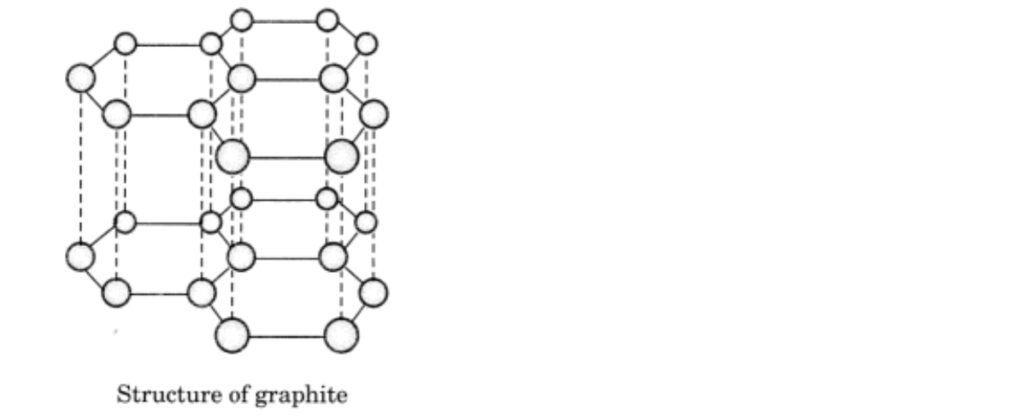
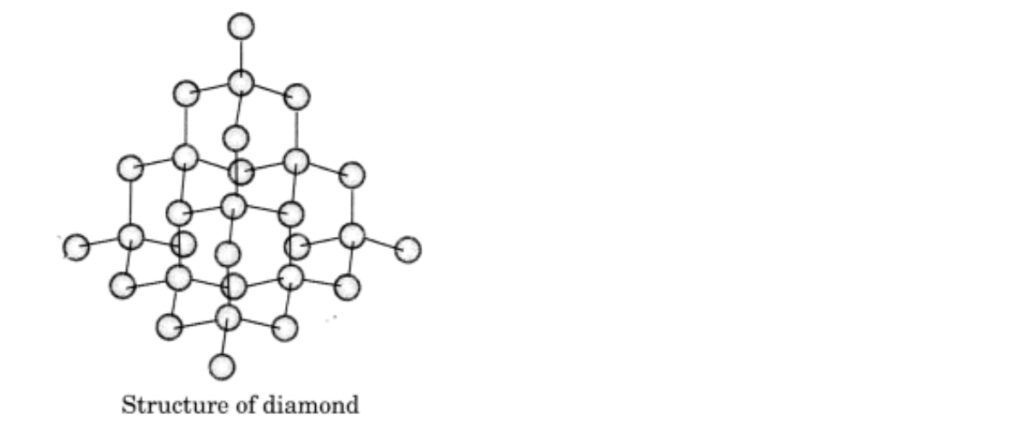
Question: Write the general IUPAC names of alcohol, carboxylic acid, aldehyde and ketone.
Answer:
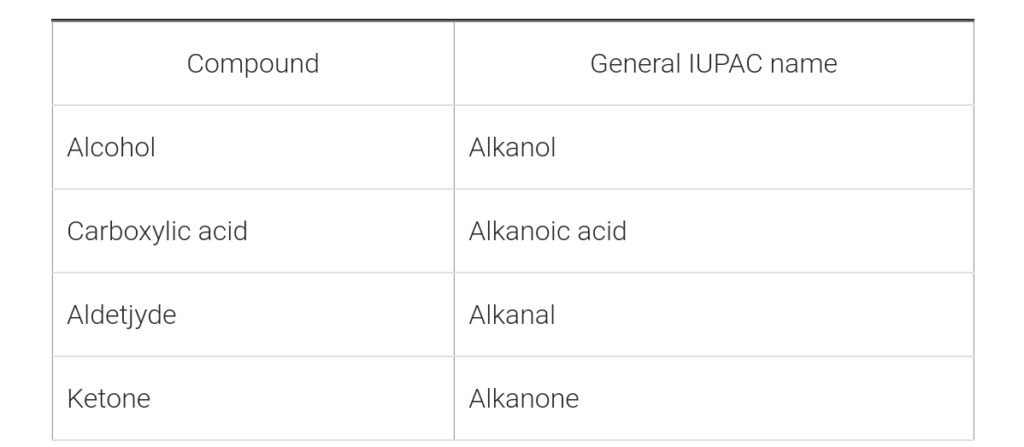
Question:. List four differences between soaps and detergents.
Answer: Soaps–
- Soaps are sodium salts of higher fatty acids.
- Biodegradable.
- Soaps cannot be used in acidic medium.
- Soaps cannot be used in hard water.
Synthetic Detergents:
- Detergents are sodium alkyl sulphates or sodium alkyl benzene sulphonates with alkyl group having more than ten carbon atoms.
- Non-biodegradable.
- They can be used in acidic medium.
- Detergents can be used even in hard water.
Question: Give two uses each of methyl alcohol and ethyl alcohol.
Answer: Uses of ethyl alcohol:
- It is used in the manufacture of dyes, perfumes, antiseptics, etc.
- It is used in alcoholic drinks.
Uses of methyl alcohol:
- It is used as a solvent
- It is used as an antifreeze
Question: What is meant by homologous series of carbon compounds? Write the general formula of(i) alkenes, and(ii) alkynes.
Draw the structures of the first member of each series to show the bonding between the two carbon atoms. [CBSE 2014]]
Answer:
Homologous series: A series of carbon compounds in which the same functional group substitutes for hydrogen on a carbon chain is called a homologous series. There is a difference of –CH2 in the molecular formulae of two nearest compounds of a homologous series. Each such series has same general molecular formula and has a general scientific name. There is a difference of 14 u (unified mass) in the molecular masses of two nearest compounds of a series.
Members of homologous series of aldehydes: H – CHO Methanal
CH3 – CHO Ethanal
C2H5– CHO Propanal
General formula:.(i) Alkenes, CnH2n. (ii) Alkynes, CnH2n-2
Extra Questions for Class 10 Science Chapter 4 Long Answer Type
Question: Write the names of the following compounds:
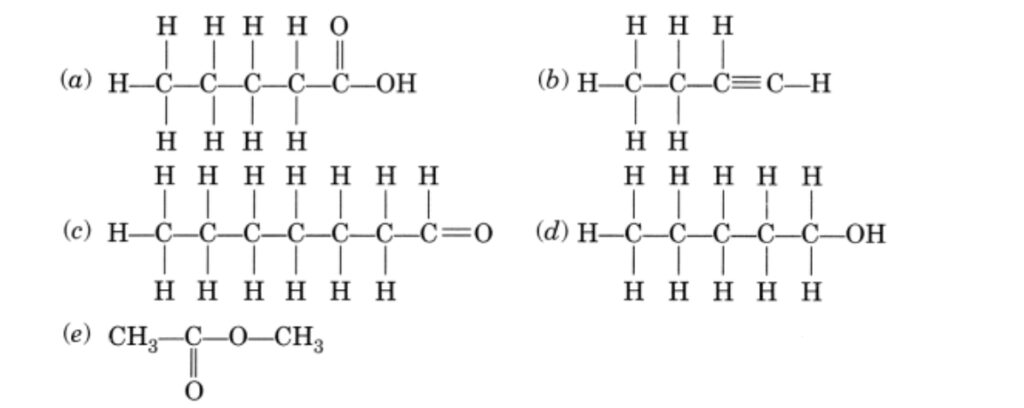
Answer:
(a) Pentanoic acid
(b) But-l-yne or Butyne
(c) Heptanal(d) Pentanol(e) Methyl ethanoate
Question: (a) Distinguish between esterification and saponification reactions of organic compounds.
(b) With a labelled diagram describe an activity to show the formation of an ester.
Answer:
(a) Esterification: When carboxylic acid reacts with alcohol in the presence of a little concentrated sulphuric acid to form ester, the reaction is called esterification

Saponification: When an ester is heated with sodium hydroxide solution then the esters get hydrolysed to form alcohol and sodium salt of carboxylic acid. This alkaline hydrolysis of esters is known as saponification as it is used in the preparation of soap.

(b) Activity to show the formation of an ester:
- 1 ml ethanol and 1 mL glacial acetic acid along with a few drops of concentrated sulphuric acid are taken in a test tube.
- The mixture is allowed to warm in a water-bath for at least five minutes.
- The hot mixture of the test tube is poured into a beaker containing 20-50 ml of water.
- A sweet smelling substance called ester is formed.
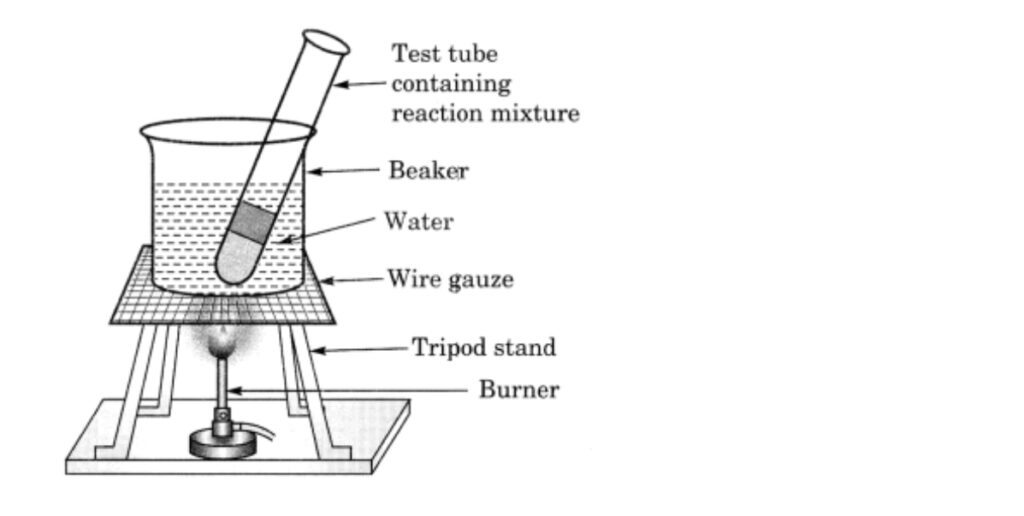
Question: List in tabular form three physical and two chemical properties on the basis of which ethanol and ethanoic acid can be differentiated. (CBSE 2012)
Answer:
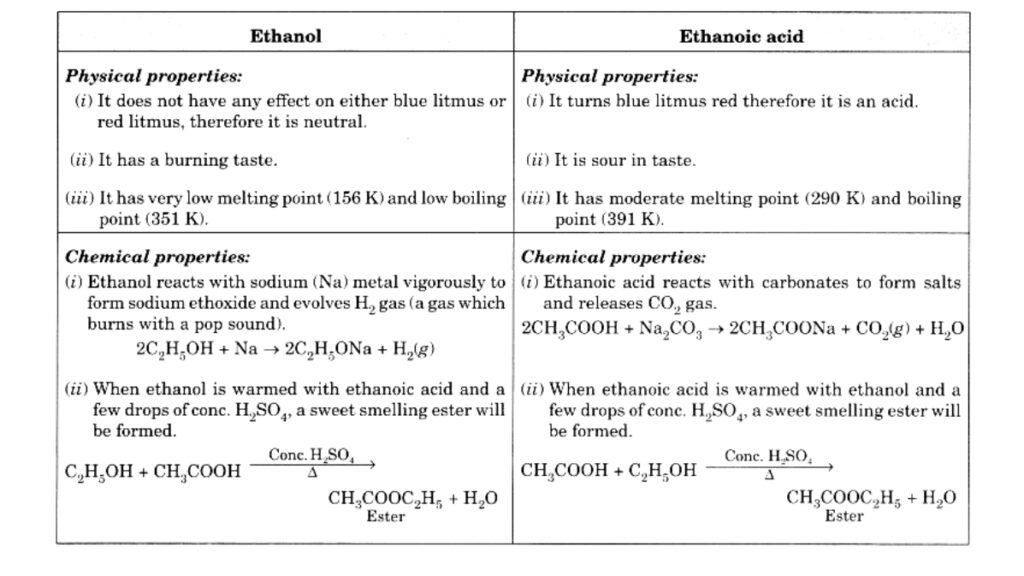
Question: Give one example each of:
1. Cracking
2. Hydrogenation
3. Dehydration
4. Substitution reaction
5. Addition reaction
Answer:
1. Cracking-

2.Hydrogenation –

3.Dehydration –

4.Substitution Reaction –

5. Addition Reaction –

Question: A salt X is formed and a gas is evolved when ethanoic acid reacts with sodium hydrogen carbonate. Name the salt X and the gas evolved. Describe an activity and draw the diagram of the apparatus to prove that the evolved gas is the one which you have named. Also, write chemical equation of the reaction involved. (NCERT Exemplar)
Answer:

X is sodium ethanoate. Gas evolved is carbon dioxide (CO²).
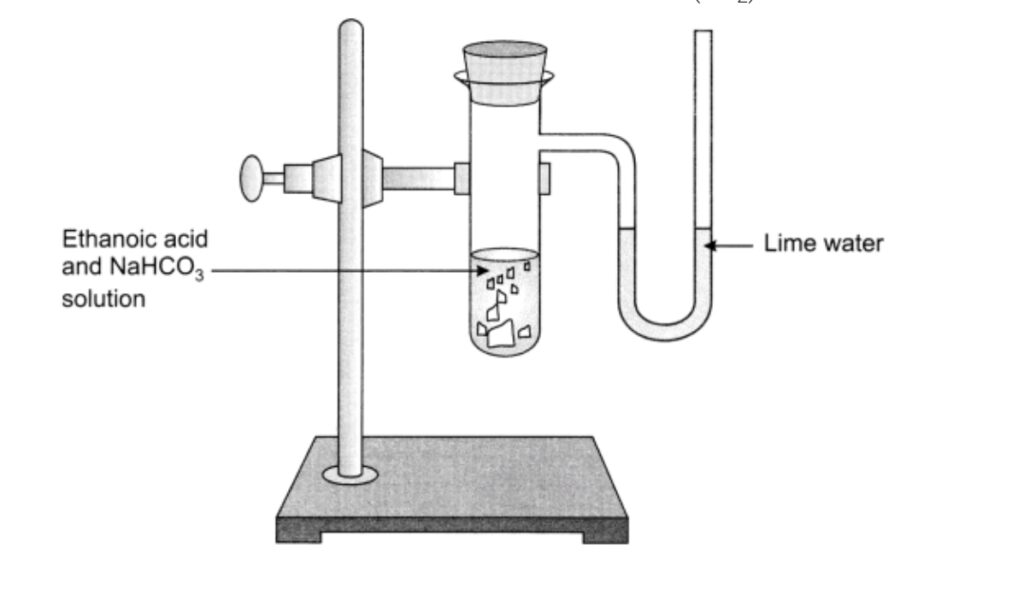
Activity:
- Take sodium hydrogen carbonate in a test tube and add 2 ml ethanoic acid in it.
- Carbon dioxide gas is evolved with brisk effervescence.
- Pass the gas through lime water, it will turn milky. This shows that the gas evolved is carbon dioxide (CO2).
Question: Intake of small quantity of methanol can be lethal. Comment. (NCERT Exemplar)
Answer: Methanol is oxidised to methanal in the liver. Methanal reacts with the component of the cells. It causes the protoplasm to coagulate. It also affect the optic nerve, due to which it causes blindness.

